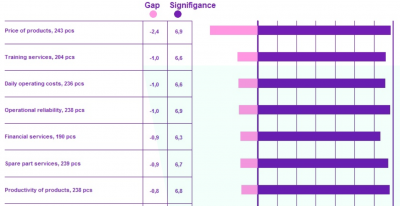Interpreting a Gap Analysis
With a Gap Analysis you can examine the factors that affect respondents’ level of satisfaction. The Gap Analysis tells you how well your organisation has managed to meet the expectations of the respondents. The Gap Analysis recognises the strength and development areas in your work, making it possible to direct actions straight to them.
The purple pillar in the Gap Analysis (long, right-facing pillar) displays each evaluated factor’s meaning to the respondents. If the pillar is long, the factor in question is important to the respondent and if the pillar is short, it does not have as much weight or importance.
The shorter, pink pillar displays the difference (gap) between the success grade and the importance grade. Positive pillars (right-facing) show factors in which success has been evaluated as higher than importance. These may be factors that are given excess investment or effort. Negative (left-facing) pillars show factors in which success has been evaluated as weaker than importance. The further left the pink pillar reaches, the more critical the factor in question is.
The factors are divided into three categories based on the Gap Analysis. The categories’ limit values may change, so please check the limit values of the research from your own material.
- Success factors = gap -0.4 or better
- Factors still to be improved = gap between -0.5 – -0.9
- Critical factors = gap -0.9 or weaker
It is important to react to factors that are high in importance with a sizeable, negative gap.
